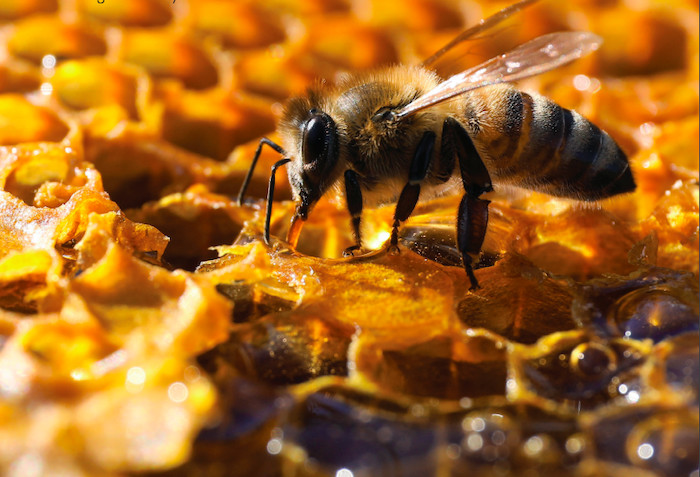
It’s time to take the edge off the colder months with some sweet elixirs provided by one of nature’s most versatile ingredients. By Anistatia Miller & Jared Brown.
At this time of year, the bees have retreated to their hives. They’re not precisely slumbering, though. Rather than venturing out, they eat their honey stores over the winter plus a few bricks of a special ‘fondant’, a cake of soft sugar that’s loaded with bee nutrients laid on the top of each hive.
Thus fortified, the bees generate enough heat to maintain a core temperature of around 35.4°C even in the coldest weather. Cold is not nearly as significant a danger for bees as damp. Isometric exercises help them ward off both. (Seriously, they spend the off-season flexing their wing muscles enough to warm their house.)
During the year, bees typically produce far more honey than they need for winter. So, beekeepers give them an ideal home, mite treatments and protection from wax moths, wasps and other predators in exchange for their surplus. And once that surplus is refined, bartenders can put it to great use.
While honey has appeared in alcoholic beverages since at least 7000 BC and is essential for making drinks such as Canchànchara, the Penicillin, Atholl Brose, and Hot Toddy, our two favourite uses – aside from making Bee’s Knees – are mead and honey liqueur. Mead is a bit of work; honey liqueur is dead simple. Both are worth it.
There are dozens of ways to make mead. All involve combining honey, water and yeast in a fermentation jar or bucket with an airlock. Beyond that, the variations are endless. We like adding oranges and cloves. Want a drier mead? Use less honey. (Pro tip: pricier honey and local honey generally make much better mead.)
• 1.5 kilos (approximately 1 litre) honey
• Water (4 litres for dry mead, 2 for sweet, and you can always add a bit of honey after fermentation)
• 2 tablespoons of strong black tea
• 1 lemon or orange, in slices
• 2 whole cloves
• Wine or champagne yeast
• Yeast nutrients
As with any fermentation project, start by sterilising the jar, airlock, any spoons and measuring cups before you combine the ingredients, using Campden tablets. Next, place jars of honey in warm water to loosen. Then combine the honey with warm water in a fermenting jug. Shake well. Add citrus, spice, tea, and yeast nutrients. Then add yeast. (Follow the package instructions for both yeast and nutrients.) If you have a hydrometer, the gravity should be around 1090. Seal the jug to keep the mixture from exploding. In a few days to a week, the yeast activity should stop. You should be able to siphon it into another jug, leaving the sediment behind. Let the mixture mature for a few more weeks. You will get more sediment. Now, you can rack it off into bottles.
Flavour combinations
Honey liqueur is nearly as simple to make as honey syrup. Combine equal parts honey syrup and spirit and you have a shelf-stable honey liqueur that is exactly half the abv of the spirit you used. We lean toward whisky for this and have found a near-infinite range of flavour combinations. A Speyside or Highland whisky with heather honey is an entirely different liqueur to an Islay with buckwheat honey. Both are gorgeous served over ice. These can also be made by the glass if you reduce the quantities to single and double measures in a jigger.
Remember: honey’s flavour depends on the flowers available to the bees, varying by season and by location. A few popular English honeys are labelled as heather, borage, lavender or ‘wildflower’. However, each locale has a unique terroir reflected in the flavour and colour of local kinds of honey. Believe it or not, the most exotic honeys come from city hives. These bees work the flowers in urban back gardens and window boxes where they encounter flowering plants from around the world.
But bees produce more than just honey. There’s also beeswax, bee pollen, royal jelly and propolis. All are worth exploring in drinks. To us, the most impressive use of bee products in a single drink comes from London bartender Christian Maspes, who in 2022, created a sustainable menu for the Churchill Bar & Terrace in Marylebone which included a drink he named the Be Hive: gin, bee pollen, hibiscus and local honey served in a beeswax cup that could be easily melted down and reformed. Mead, honey liqueur and bee products give us all a reason to rally round and save the bees for years to come.


